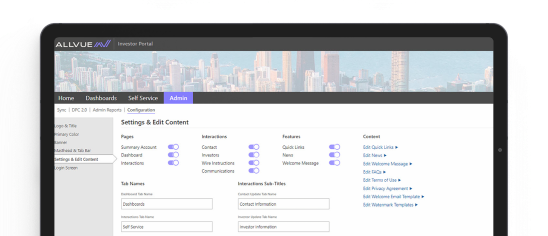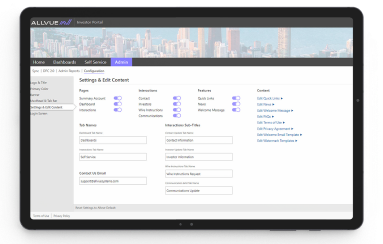
By: Michelle Wu
Head of Marketing
May 20, 2025
As private markets enter a new phase of maturity, fund managers and service providers are facing converging pressures that are reshaping the industry’s technological, operational, and capital-raising frameworks. At DealCatalyst 2025, panels spanning BDC strategy, fund operations, AI integration, and data governance offered a front-row seat to these evolving dynamics.
Several key themes stood out across sessions: the rise of generative AI, the push for operational standardization, the emergence of secondary markets, and the increasing scrutiny from institutional allocators. These trends mark a transition from fragmented, reactive operations to proactive, data-driven decision-making. As firms adapt, platforms like Allvue’s new Agentic AI Platform and Nexius Data Platform will be key to enabling intelligent scale, market agility, and differentiation through insight.
The discussions underscored that success in this new landscape depends on more than performance. It hinges on visibility, adaptability, and the ability to deliver investor-grade information quickly and accurately.
From Dividend Yield to Data-Led Strategy: The New BDC Playbook
The BDBC market discussion illustrated how far the industry has come. A decade ago, dividend yield primarily judged performance, regardless of NAV erosion or portfolio risk. Today, investors demand a broader view that includes return on equity (ROE), balance sheet structure, and data transparency.
Equity and debt investors, analysts, and rating agencies are now stakeholders, each requiring different disclosures. Managing these groups requires dedicated resources, streamlined data flows, and a digital backbone that supports transparency and control.
This evolution underscores the need for robust data architecture. Delivering timely, explainable metrics is no longer a compliance task—it’s a competitive edge. Allvue’s Nexius Data Platform is built to meet this need, normalizing and unifying data across portfolios and asset types to give investment teams a real-time, consolidated view of exposures, valuation impacts, and risk signals.
Speakers emphasized that this shift toward ROE and portfolio quality metrics isn’t just cosmetic—it’s a strategic repositioning. The firms that win capital today are the ones that can prove the sustainability of returns and the integrity of their data.
AI in Private Credit: From Automation to Explainability
AI was a hot topic across multiple panels, with forward-looking firms sharing how they’re leveraging machine learning and large language models to automate underwriting tasks, surface risk indicators, and accelerate scenario modeling.
Critically, these tools are designed to support—not replace—human analysts. “We want our analysts focused on judgment,” said one panelist. “The platform does the legwork, but the human makes the call—and can trace how they got there.”
Explainability is key. With regulations like the EU AI Act and emerging U.S. laws demanding transparency in AI-assisted credit decisions, firms must build infrastructure that tracks data lineage, clarifies model logic, and makes every recommendation auditable.
Allvue’s Agentic AI Platform embraces these standards. We’re embedding AI into the heart of our platform suite to drive predictive insights, intelligent workflows, and faster decision-making, while maintaining built-in guardrails for compliance and traceability.
Panelists cautioned that black-box algorithms without proper governance could expose firms to reputational and regulatory risk. The future of AI in private credit lies in explainable intelligence that enhances, not overrides, human expertise.
Liquidity, Secondary Markets, and the Infrastructure Gap
Liquidity was another recurring theme, especially in the context of secondary markets, redemptions, and fund financing. With institutional allocators increasing their exposure to private credit, managers are under pressure to balance bespoke structuring with scalable, liquid execution.
But liquidity relies on infrastructure. Without standardized identifiers, interoperable systems, and clean data, settlement lags and reconciliation delays remain common. Panelists highlighted ongoing friction from manual wire processing, inconsistent notices, and the continued use of faxes—even at scale.
Encouragingly, the industry is beginning to address these gaps. LSTA initiatives to define consistent message formats and promote identifiers like CUSIPs and loanX IDs are gaining traction. But real progress depends on interoperable technology and vendor collaboration.
Several speakers noted that the absence of standardized messaging and counterparty integration can be a silent killer of deal velocity. As more managers explore liquidity windows or prepare for active secondary trading, clean data and systems integration will become essential.
Operational Efficiency as a Strategic Lever
Historically, non-standardization has been a creative advantage in private credit. But as portfolios grow and LP oversight tightens, operational inefficiencies carry increasing risk. One panelist noted that allocators are now asking managers about T+3 reconciliation and accrual forecasting accuracy, not just IRR.
The takeaway: investors view operational maturity as a proxy for overall fund quality.
Leading firms are adopting AI-assisted reconciliation tools, shared APIs, and modular tech stacks that flex with their evolving needs. One speaker said, “We don’t know what our clients will ask for next. The platform has to flex.”
This is core to Allvue’s approach. Our modular architecture supports complex, bespoke workflows while ensuring data consistency, compliance, and auditability across syndicated BSLs and custom bilateral loans alike. It’s how managers scale without compromising agility.
Operational excellence isn’t just about reducing headcount or cost—it’s about enabling responsiveness. Firms that can close books faster, deliver real-time insights, and adapt to new investor demands will gain a strategic edge.
Allocator Expectations and Public-Private Convergence
Allocators are bringing public-market expectations to private investments: real-time transparency, redemption options, rigorous valuation, and stronger governance.
Panelists explored how the rise of perpetual funds and quarterly redemptions is accelerating the need for proactive liquidity management and precision forecasting. Meanwhile, allocators expect forward-looking analytics, not just historical performance.
Firms that meet these demands with real-time investor-ready dashboards are pulling ahead. Allvue’s Nexius Data Platform enables this, giving managers and allocators secure, customizable access to dynamic portfolio insights, scenario modeling, and risk exposure analytics—all from a single system.
As one speaker said, “Allocators are no longer tolerating quarterly PDFs—they want clickable, real-time data they can interrogate themselves.” This demand is reshaping how fund managers think about their client experience and investor relations.
Looking Ahead: Infrastructure for What’s Next
DealCatalyst 2025 made one thing clear: change in private markets is accelerating. Whether it’s AI, operational modernization, or allocator expectations, firms need infrastructure that adapts fast and intelligently.
Technology is no longer a back-office tool. IT’s a core enabler of alpha, resilience, and growth.
At Allvue, our Spring 2025 launches—Agentic AI Platform and Nexius Data Platform —are designed to help private market managers move faster, with more insight and control. We’re building tools that align with how the industry is evolving, so our clients can lead—not follow.
From fundraising and reporting to compliance and credit analysis, modern private markets require technology that can do more than keep up—it must anticipate. The platforms that succeed will be those built to flex and scale with evolving market expectations.
Rethinking your tech stack? Let’s talk.
Schedule a call today to learn how Allvue is helping firms turn complexity into competitive advantage.
More About The Author

Michelle Wu
Head of Marketing
Michelle is a dynamic marketing leader with 15+ years of experience in capital markets, fintech, and cybersecurity technology industries. Prior to joining Allvue, Michelle was the Vice President of Product Marketing at SecurityScorecard, a global leader in cybersecurity ratings, and was the Head of Security & Compliance Marketing at Box. Before moving into cybersecurity, she led the Banking & Securities GTM strategy at Intralinks and covered capital markets clients at HSBC. She holds an MSc in Media & Communications from the London School of Economics and a BS in Marketing & Finance from NYU Stern School of Business.


